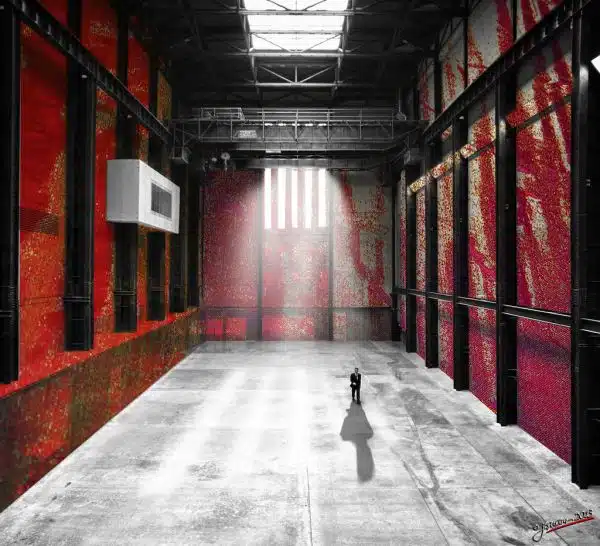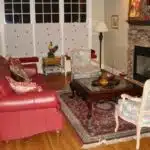Gallery walls have become a popular trend in the world of interior design. They add character and personality to a room, while also showcasing artwork or photographs that hold meaning for the homeowner. Creating a gallery wall may seem daunting at first, but with the right approach and steps, it can be easily achieved.
In this article, we will explore eight easy steps to create a stunning gallery wall that will not only enhance your space but also reflect your personal style and taste. From choosing the right frames to arranging the pieces on the wall, we will guide you through every step of the process. By following these simple yet effective tips, you can transform an empty wall into a captivating display that tells your unique story.
Assessing Your Space And Style
As you stand in front of a blank wall, imagining your gallery wall coming to life, it’s important to assess both your space and style. Evaluating your preferences before diving into the project will help you create a cohesive display that reflects your personality and interests.
Start by measuring the space you plan to use for your gallery wall. Consider the height, width, and any obstacles such as light switches or windows. This will give you a better idea of how many pieces you’ll need and what sizes will work best. Don’t forget to also take into account any furniture or decor that will be nearby.
Next, think about your personal style. Do you prefer a clean and minimalist look or do you like bold colors and patterns? Are there specific themes or motifs that speak to you? Take note of these preferences as they’ll guide your choices when selecting artwork or photographs for your display. By assessing both your space and style, you’ll be well on your way to creating a stunning gallery wall that truly reflects who you are.
With these considerations in mind, it’s time to move on to choosing the perfect artwork or photographs for your display.
Choosing Your Artwork Or Photographs
- When creating a gallery wall, it is important to first analyze the space to determine the size, shape, and style of artwork or photographs that will best suit the area.
- The selection of artwork or photographs should be considered carefully to create balance and harmony in the gallery wall.
- It is important to determine the color palette and the type of artwork or photographs that will be included in the gallery wall.
- The gallery wall should be designed to reflect the personality and style of the homeowner, as well as complement the existing decor of the space.
Analyzing Your Space
Before choosing your artwork or photographs, it’s crucial to analyze your space. This step helps you determine the perfect location for your gallery wall and the type of art that would complement the existing features of your room. Start by considering the lighting in your space. Natural light enhances artwork and adds a fresh vibe to any room. Conversely, harsh artificial lighting can wash out colors and make them appear dull.
Next, think about how you can incorporate furniture into your gallery wall design. If you have a sofa or a statement piece of furniture, you can create a focal point by placing artwork above it. Alternatively, if you have a small space, consider using smaller pieces or creating a vertical gallery wall that goes up towards the ceiling. Don’t forget to leave some negative space around your artwork to avoid overcrowding.
Finally, consider the overall vibe that you want to create with your gallery wall. Do you want it to be bold and eclectic? Or do you prefer a more minimalist look? Analyzing your space helps identify the perfect style for your gallery wall while ensuring that it complements rather than clashes with other elements in the room. By doing so, you’ll create an inviting and cohesive atmosphere that elevates the overall aesthetic of your home.
Selecting Artwork/Photographs
After analyzing your space, the next step in creating a gallery wall is selecting the artwork or photographs that will be displayed. When choosing pieces to include, it’s important to consider mixing styles and hanging techniques to create visual interest. For example, you can mix modern and traditional pieces or hang them in a variety of ways, such as in a grid or salon style.
When selecting your artwork or photographs, think about the overall color scheme of your room and choose pieces that complement it. You can also choose items based on their subject matter or theme. For instance, if you have a beach-themed room, consider displaying photographs of ocean views or seashells. Additionally, don’t be afraid to incorporate different mediums such as paintings, prints, and photographs to add texture and depth.
Once you’ve chosen your pieces, experiment with different arrangements before committing to one layout. Start by laying out all the items on the floor and moving them around until you find a composition that works well together. Don’t forget to consider negative space between each item as this will help prevent overcrowding. By following these tips for selecting artwork and experimenting with different hanging techniques, you’ll create a unique gallery wall that reflects your personal style while enhancing the overall aesthetic of your home.
Selecting The Right Frames
When selecting the frames for your gallery wall, it’s important to consider the overall aesthetic of your space. Mixing textures is a great way to add visual interest and dimension to your gallery wall. Consider using frames that have different finishes such as wood, metal, or even acrylic. This will create a dynamic look that draws the eye in.
Another crucial aspect of frame selection is choosing the right matting. The matting can serve as a buffer between the artwork and the frame, preventing any damage from occurring over time. It also adds an additional layer of depth and texture to your gallery wall. When selecting matting, opt for a color that complements both the artwork and the frame.
To make things easier, here are four key tips for selecting the right frames:
- Choose frames that are similar in style but vary in size.
- Make sure all of your frames have a consistent color scheme.
- Consider using unconventional shapes or sizes to add visual interest.
- Don’t be afraid to mix and match different types of frames.
By following these guidelines, you’ll be well on your way to creating a beautiful gallery wall that perfectly suits your space. Next up, we’ll delve into deciding on a color scheme for your gallery wall – an essential step in bringing everything together seamlessly.
Deciding On A Color Scheme
Color Scheme:
Color psychology is an essential aspect of interior design. It has the power to influence our moods, emotions, and behavior. Choosing a color scheme for your gallery wall can be challenging, but it is crucial to understand the impact of colors on your space and the people in it. Warm colors such as reds, oranges, and yellows can create an energetic and lively atmosphere. On the other hand, cool colors like blues, greens, and purples can evoke calmness and relaxation.
Mixing and matching:
Once you have decided on a color scheme for your gallery wall, it’s time to mix and match different shades of colors. Instead of sticking with one color tone, try incorporating different hues to add depth and interest to your space. You could also consider adding neutral tones like beige or gray to balance out bright colors. Using different textures such as wood frames or metal accents can also add variety to your gallery wall.
Table:
| Color | Mood | Example |
|---|---|---|
| Red | Energetic | Fire engine red frame |
| Orange | Excitement | Tangerine orange matting |
| Yellow | Happy | Lemon yellow frame |
| Blue | Calmness | Sky blue matting |
| Green | Relaxation | Forest green frame |
Preparing Your Wall:
Now that you have chosen a color scheme and mixed different shades together for your gallery wall, it’s time to prepare your wall for installation. Start by measuring the size of your selected frames or art pieces against the available wall space. Make sure there is enough space between each piece so that they don’t look cluttered or cramped together. Consider using painter’s tape or a level tool to ensure that all frames are hung straight before making any holes on the walls. A well-prepared gallery wall will not only enhance the aesthetic appeal of your room but also create a harmonious environment that inspires and delights.
Preparing Your Wall
Before you start hanging art, measure your wall space to ensure that you have enough room for all the pieces you want to display. Measuring tools such as a tape measure and level are essential in this process. Measure the height and width of the wall space where you plan to hang your gallery wall. This will help you determine how many pieces of art can fit in the space and how much spacing is needed between each piece.
Once you have measured your wall, it’s important to inspect it for any damages or repairs that may need to be made before hanging your artwork. Look for cracks, holes, or other imperfections on the surface of the wall. If there are any issues, make sure to address them before starting the installation process. This will ensure that your gallery wall looks professional and polished.
Take the time to repair any damaged areas on your wall before proceeding with hanging your art pieces. Fill in any holes or cracks with spackle or putty and sand them down until smooth. Use touch-up paint if necessary to blend in any repaired areas with the rest of the wall. By preparing your wall beforehand, you’ll create a clean canvas that’s ready for your artwork installation template – which we’ll discuss in the next section!
Creating A Template For Placement
- Creating a template for placement begins with determining the layout of the wall art.
- Measuring wall space is imperative to ensure the chosen art will fit the intended space.
- Establishing proportions is key when creating a template for placement to ensure the artwork is balanced.
- To ensure the artwork is symmetrical, it is important to measure the center of the wall and then build outward.
- When determining the proportions for the wall art, it is important to factor in the size, shape, and color of the art pieces.
- Experimenting with the layout is essential to ensure the template for placement is aesthetically pleasing.
Determining Layout
When determining the layout for your gallery wall, there are two main approaches to consider: symmetry versus asymmetry. A symmetrical layout involves arranging your artwork in a balanced and uniform manner, while an asymmetrical layout allows for more creativity and variation in placement. Both options can be effective, but it ultimately depends on the aesthetic you are trying to achieve.
Mixing and matching different sizes and types of artwork can also add depth and interest to your gallery wall. Consider incorporating a mix of photographs, paintings, prints, and other decorative pieces to create a cohesive yet eclectic display. You can also experiment with different frames and matting styles to further enhance the visual appeal of your gallery wall.
Once you have determined the overall layout and selection of artwork for your gallery wall, it is important to create a template for placement. This can be done by tracing each piece onto kraft paper or using painter’s tape to map out where each item will go on the wall. By taking the time to create a template beforehand, you can ensure that your gallery wall looks polished and professional once it is hung up on display.
Measuring Wall Space
When it comes to creating a gallery wall, accurately measuring your wall space is crucial for achieving a polished and professional look. Measuring accuracy is key in ensuring that your artwork is evenly spaced and properly aligned. To do this, you will need a few essential tools such as a measuring tape or ruler, level, and pencil.
Start by measuring the height and width of the wall space where your gallery wall will be placed. Next, use these measurements to create a template on kraft paper or other materials. Make sure to include markings for any existing furniture or fixtures that may affect placement. By using a level and pencil to mark out where each piece of artwork will go beforehand, you can avoid mistakes and ensure that everything is properly aligned.
While creating a template may take some extra time and effort, it ultimately pays off in the long run. Not only does it help with measuring accuracy, but it also allows you to experiment with different arrangements before committing to hanging anything on the wall. Taking these steps can make all the difference in achieving a successful gallery wall display that enhances the overall aesthetic of your space.
Establishing Proportions
Creating a template for placement is an essential step in achieving a well-balanced gallery wall that enhances the overall aesthetic of your space. However, accurately measuring your wall space and marking out where each piece of artwork will go are not the only things to consider. Another factor to keep in mind is proportion balancing. This involves taking into account the size and shape of each piece relative to the others to create a visually pleasing layout.
When establishing proportions, it’s important to consider the overall balance of the gallery wall. You may want to vary the sizes and shapes of the artwork, but try to maintain a sense of harmony by grouping similar pieces together or distributing them evenly throughout the arrangement. Experiment with different layouts on your template before committing to hanging anything on the wall.
Don’t be afraid to take risks and think outside of the box when creating your gallery wall. Proportion balancing can be a challenge, but by using your creativity and intuition, you can achieve an aesthetically pleasing display that showcases your unique style and personality. With careful planning, experimentation, and attention to detail, you can create a gallery wall that serves as a beautiful focal point for your space.
Laying Out The Gallery Wall On The Floor
Did you know that 73% of homeowners struggle with decorating their walls? Creating a gallery wall might seem intimidating, but with the right approach, it can add character and personality to your living space. Once you have chosen the pieces that will go on your wall, the next step is to lay them out on the floor.
Start by clearing a large space in your room where you can work comfortably. Gather all your frames and lay them out on the floor in front of you. Mix textures and sizes to create interest and depth. Don’t be afraid to incorporate different materials such as wood, metal or even fabric into your display. The more eclectic your mix, the better.
Once you have arranged your frames on the floor, step back and take a look at the overall composition. Is there one frame that catches your eye? Use it as a focal point for your gallery wall. This will create visual interest and give direction to your design. Keep in mind that balance is key; aim for an even distribution of frames throughout the display.
Now that you have laid out your gallery wall on the floor, it’s time to move on to nailing the hanging mechanisms onto each frame so they can be hung securely on your wall.
Nailing The Hanging Mechanisms
After laying out the gallery wall on the floor, the next step is to nail the hanging mechanisms. There are different hanging mechanisms available in the market, and it is important to choose the right one for your frames. The most common hanging mechanisms are D-rings, sawtooth hangers, and wire.
D-rings are perfect for frames that have two suspension points at the back. They provide a secure hold and prevent any movement of the frame. Sawtooth hangers, on the other hand, are ideal for smaller frames that weigh less than 10 pounds. They are easy to install but can be tricky to align perfectly. Lastly, wire is suitable for larger frames that have only one suspension point at the back. It provides flexibility in terms of adjusting the frame’s height and leveling it.
Common hanging mistakes include using incorrect hardware, not measuring properly, and not securing it properly to the wall. Make sure to read instructions carefully and use appropriate hardware for your wall type. Additionally, measure twice before drilling any holes on your wall to avoid making irreversible mistakes. Lastly, ensure that you secure each mechanism properly by using anchors or screws designed for your wall type.
Next up is hanging the frames! Ensure that you have all tools ready before starting this process. Stay tuned for more tips on how to create a stunning gallery wall in eight easy steps!
Hanging The Frames
After selecting your desired frames and arranging them on the floor, it’s time to hang them up. This step is crucial in creating a cohesive and visually appealing gallery wall. Mixing shapes adds dimension to the display, so don’t be afraid to incorporate circular or oval frames alongside the traditional rectangular ones.
Using different hanging techniques can also make your gallery wall more interesting. Consider using picture rails or floating shelves for a modern twist or mix in decorative hooks for a more eclectic look. Make sure to measure each frame before hanging it up, as precision is key in creating a well-balanced arrangement.
When hanging your frames, keep in mind that the center of each piece should be at eye level. If you’re unsure about placement, use painter’s tape or post-it notes to mock up where you want each frame to go before committing to any holes in the wall. With these tips in mind, you’re ready to move onto securing the artwork and completing your stunning gallery wall display.
Securing The Artwork
When it comes to securing your artwork on the wall, there are several options available. One of the most common ways is by using different types of hangers. Picture hangers or wire hangers can be used depending on the weight of the artwork. For heavier pieces, it is recommended to use two hangers instead of one to distribute the weight evenly.
Alternatively, there are other ways to secure artwork without using traditional hangers. One option is adhesive strips that can hold up to a certain weight limit. Another option is using Velcro strips, which provide a strong hold while also allowing for easy adjustments if needed. It’s important to note that these alternative methods may not work for all types of surfaces and should be tested beforehand.
Ultimately, whichever method you choose, make sure it is secure and able to support the weight of your artwork. Taking extra precautions will ensure that your gallery wall remains intact over time without any damage or accidents. In the next section, we’ll discuss how to adjust for balance and proportion in order to achieve a cohesive look for your gallery wall.
Adjusting For Balance And Proportion
After securing the artwork, it’s time to focus on achieving balance and proportion in your gallery wall. Symmetry vs asymmetry is one of the most important considerations when creating a gallery wall. While symmetry can create a sense of order and formality, asymmetry adds visual interest and movement to your display.
Mixing sizes and shapes of frames and artwork is another way to achieve balance and proportion. Don’t be afraid to mix horizontal and vertical orientations or incorporate different frame styles for a dynamic look. Experiment with layering pieces by placing larger items towards the back and smaller items towards the front.
Lastly, don’t forget to add personal touches that reflect your style and personality. Whether it’s incorporating family photos or adding unique decor pieces, these elements will make your gallery wall truly yours. By following these tips for achieving balance and proportion, you’ll have a stunning gallery wall that showcases your favorite art pieces in a cohesive yet visually interesting way.
Adding Personal Touches
Adding Personal Touches:
Now that you have assembled your gallery wall, it is time to add personal touches to make it truly unique. Customizing your gallery wall is an essential step in making it a reflection of your personality and style. You can do this by incorporating items that hold sentimental value or represent your interests.
One way to add personal touches is by including family photos or artwork created by loved ones. These pieces not only add a personal touch but also create a sense of nostalgia and warmth. Additionally, adding small decor items such as vases, candles, or decorative objects can complement the artwork and bring cohesion to the wall.
Another way to customize your gallery wall is by incorporating unexpected elements such as mirrors or vintage frames. This will add depth and visual interest to the wall while maintaining a cohesive look. Remember, the goal is to create a space that reflects your unique style and personality.
Transition into the subsequent section:
As you add these final touches to your gallery wall, don’t forget about lighting! The right lighting can highlight specific pieces on the wall and create a warm ambiance in the room. Let’s explore how to light your gallery wall for maximum impact.
Lighting Your Gallery Wall
While some may argue that adding accent lighting to a gallery wall is an unnecessary expense and effort, it can truly make all the difference in showcasing your art collection. A well-lit display not only draws attention to the pieces but also creates a warm and inviting ambiance in any room. Fortunately, there are plenty of DIY fixtures available that make adding accent lighting both affordable and easy.
When choosing your accent lighting, it’s important to consider the style of your gallery wall. For a more modern look, opt for sleek track lighting or minimalist sconces. If you have a more eclectic collection, vintage-inspired light fixtures can add charm and character to the display. Additionally, consider the placement of your lights – aim for even coverage across the entire wall to avoid any shadows or dark spots.
If you’re feeling particularly creative, try making your own DIY light fixtures using materials such as copper piping or reclaimed wood. This not only adds a personal touch to your gallery wall but also allows for complete customization of the size and shape of each fixture. Whatever route you take, be sure to follow proper safety precautions when installing any electrical components.
Transition: While adding accent lighting is an essential step in creating a stunning gallery wall, it’s equally important to maintain its appearance over time.
Maintaining Your Gallery Wall
Once you have created your gallery wall, it is important to maintain it properly. This will ensure that your artwork looks great for years to come. One of the first things you should do is choose artwork that is of high quality and can withstand the test of time. This means selecting pieces that are made of durable materials and are resistant to fading.
Another crucial aspect of maintaining your gallery wall is hanging techniques. It is important to use the correct tools and hanging methods to ensure that your artwork stays securely on the wall. For example, if you have heavier pieces, you will want to use anchors or screws instead of nails. Additionally, it is essential to measure and space out your artwork evenly on the wall so that everything appears balanced.
Overall, maintaining a gallery wall requires attention to detail and consistent upkeep. By choosing artwork wisely and using proper hanging techniques, you can enjoy your display for years to come. With a little bit of effort, you can keep your gallery wall looking fresh and vibrant while also bringing joy and inspiration to those who view it.
Enjoying Your New Space
Maintaining your gallery wall is crucial in preserving its beauty and functionality. However, enjoying the new space that you have created is equally important. According to a recent survey, homeowners who incorporate personal touches into their home decor are more likely to feel a sense of pride and satisfaction with their living spaces. With that said, let’s explore how we can maximize the functionality of our gallery wall while incorporating our personal style.
The first step in enjoying your new space is to take a step back and admire your work. Your gallery wall should reflect your personality and style, so take some time to appreciate what you have created. Next, consider how you can make the most out of this new focal point in your room. Perhaps adding a statement piece of furniture or accentuating the natural lighting will enhance the overall ambiance of your space.
Another way to maximize functionality is by using your gallery wall as an organizational tool. You can use it to display family photos, artwork, or even as a memo board for important reminders and notes. Additionally, consider incorporating shelves or hooks into your gallery wall design for added storage options. These small additions not only add practicality but also contribute to the overall aesthetic appeal of your space.
Incorporating personal touches into your gallery wall design is essential in making it feel like home. Consider adding sentimental items such as souvenirs from travels or cherished family heirlooms. Don’t be afraid to mix different styles and textures to create an eclectic yet cohesive look. Remember that this is your space, so let it reflect who you are! By following these tips on maximizing functionality and incorporating personal touches, you’ll be able to enjoy your new gallery wall for years to come without ever feeling like it’s outdated or impersonal.
Conclusion
Creating a gallery wall is an excellent way to display your art collection or photographs and add personality to your living space. By following the eight easy steps outlined in this article, you can create a beautiful and cohesive gallery wall that reflects your style and taste.
Assessing your space and style is essential before starting any project. Consider the size of your wall, the furniture in the room, and the colors used in your decor. This will help you choose artwork or photographs that complement your existing design scheme. Selecting the right frames and deciding on a color scheme are also critical steps in creating a cohesive gallery wall.
For example, imagine you have a large blank wall above your sofa. You could select a variety of framed black-and-white photographs that showcase different moments in your life. Choosing simple black frames would tie them together nicely, while adding pops of color with accessories like decorative pillows or throws can give the space some character.
Whether you’re an interior design enthusiast or just looking for ways to spruce up your home, creating a gallery wall is an excellent way to showcase artwork or photographs. By following these eight easy steps, you can create a stunning display that reflects your personal style and adds value to any room in your home.
Image Credits
- “the man who dreamed of painting the walls of the Tate Gallery” by jesuscm (featured)




























